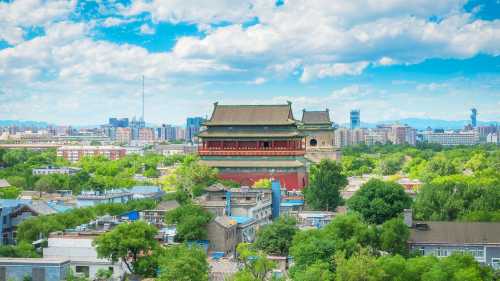Popular Trip Moments
The Majesty of Tiananmen Square | A Journey Through the Splendor of the Old Summer Palace | Cool Breeze Arrives, Perfect Time for a Vacation! | BEIHAI PARK · THE FORBIDDEN CITY’S FORMER BACKYARD PLAYGROUND | Where Emperors Sailed for Pleasure – Beijing’s 1,000-Year-Old Watercolor Comes Alive | A Stroll Through Yuanmingyuan: Echoes of Imperial Splendor | First Glimpse: The Ginkgo Boulevard of Yuanmingyuan | 📍Temple of Heaven, Beijing (天坛) | 5,000 Years of Craftsmanship Under One Roof | Cypress Shadows and Ginkgo Gold – The Seasons of Ditan Park | The Summer Palace Pastry Shop: Where History Meets Culinary Delights | 🧱🇨🇳 Avoid the Crowds: Explore Mutianyu (慕田峪) instead of Badaling! | Discover Delight at Huaxi Live Wukesong! | 🌿 A Tranquil Oasis Next to Tiananmen — Zhongshan Park (中山公园) | The Hall of Abstinence – Heaven’s Silent Sanctuary | Hall of Benevolence and Longevity: The Imperial Throne Hall of the Summer Palace | 【Universal Studios Beijing|The Ultimate Carnival of Magic and Adventure!】 | 🌄 The Best View of the Forbidden City — Jingshan Park (景山公园) | Wandering in a Painting: The Scenic Beauty by Kunming Lake | The Blue Roof of Beijing"– Geometry Meets Divinity in Ming Dynasty’s Perfect Circles | Strolling Through the Summer Palace: From Stone Bridge to Qingyan Marble Boat | Dive into the vibrant atmosphere at Q Mex! | Walking Through Imperial History at the Forbidden City | This Isn’t Just A Wall – It’s China’s Spine Turned To Stone | Add it to your top list for dates and gatherings | Autumn Colors the Summer Palace: The Multicolored Back Lake | The Tower of Buddhist Incense – A Celestial Pagoda Floating Above Kunming Lake | Enjoy This Architectural Masterpiece! | Echoes of Heaven – A Walk Through Beijing’s Temple of Heaven | Every Artifact Here Is A Centuries-old Masterpiece—Don’t Rush It!
Trending Travelogues
Recommended Attractions at Popular Destinations
Popular Attractions in Bangkok | Popular Attractions in Manila | Popular Attractions in Tokyo | Popular Attractions in Taipei | Popular Attractions in Hong Kong | Popular Attractions in Seoul | Popular Attractions in Kuala Lumpur | Popular Attractions in Los Angeles | Popular Attractions in Shanghai | Popular Attractions in New York | Popular Attractions in Shenzhen | Popular Attractions in Osaka | Popular Attractions in Singapore | Popular Attractions in London | Popular Attractions in Guangzhou | Popular Attractions in San Francisco | Popular Attractions in Beijing | Popular Attractions in Macau | Popular Attractions in Bali | Popular Attractions in Jakarta | Popular Attractions in Paris | Popular Attractions in Ho Chi Minh City | Popular Attractions in Istanbul | Popular Attractions in Phuket | Popular Attractions in Chicago | Popular Attractions in Seattle | Popular Attractions in Toronto | Popular Attractions in Orlando | Popular Attractions in Cebu | Popular Attractions in Chiang Mai
Popular Restaurants in Beijing
Made In China | TRB Hutong | Rive Gauche | AZUR | CAI YI XUAN | IL RISTORANTE - NIKO ROMITO | 1949 - Duck de Chine | MIO | China Grill | MAISON FLO | HUA'S RESTAURANT | BRASSERIE 1893 | PeKing HOTPOT | THE HOUSE OF RONG | Huguosi Restaurant Xicheng | Fu Chun Ju | Metrodolitan Restaurant | Gastro Esthetics at DaDong | Ciqikou Old Bean Juice Shop (Shop The Temple) | The Horizon Chinese Restaurant | Siji Minfu Roast Duck (Gugong) | Country Kitchen | SHENG YONG XING ROAST DUCK RESTAURANT | Qu Lang Yuan | DONG LAI SHUN | Bai Jia Da Yuan Restaurant | PALACE | JING RESTAURANT | HUDA RESTAURANT | Bianyifang Restaurant
Popular Ranked Lists
Popular Trending Attractions in Shenyang | Popular Trending Attractions in Sanya | Popular Trending Attractions in Tianjin | Top 10 Trending Attractions in Chongqing | Top 50 Must-Visit Restaurants in Koh Samui | Top 50 Must-Visit Restaurants in Chaozhou | Top 10 Luxury Hotels near Krasnogorsky District, | Popular Premium Hotels in Alghero | Popular Luxury Hotels in Yvelines | Top 10 Trending Attractions in Chun'an | Popular Trending Attractions in Kunming | Top 50 Must-Visit Restaurants in Songyang | Top 50 Must-Visit Restaurants in Melbourne | Popular Premium Hotels in Oakland | Top 10 Luxury Hotels near Fishers | Popular Luxury Hotels Near Slupski | Popular Trending Attractions in Sapporo | Top 10 Trending Attractions in Xi'an | Top 50 Must-Visit Restaurants in Hanoi | Top 50 Must-Visit Restaurants in Auckland | Popular Trending Attractions in Anji | Popular Luxury Hotels Near Pitesti | Top 50 Must-Visit Restaurants in Changsha | Popular Premium Hotels Near Lancaster County | Top 50 Must-Visit Restaurants in Frankfurt | Top 50 Must-Visit Restaurants in New York | Top 50 Must-Visit Restaurants in Tokyo | Popular Luxury Hotels in Tov | Top 10 Luxury Hotels near Sin el Fil | Popular Luxury Hotels in Erdene
About
Payment Methods
Our Partners
Copyright © 2025 Trip.com Travel Singapore Pte. Ltd. All rights reserved
Site Operator: Trip.com Travel Singapore Pte. Ltd.
Site Operator: Trip.com Travel Singapore Pte. Ltd.




















